#specifically the black gene [B] is the eumelanin gene
Explore tagged Tumblr posts
Note
Idk if this has already been asked but why are chocolate and cinnamon cats seemingly so rare compared to red or black, if you know?
so black, chocolate, and cinnamon are all different presentations of eumelanin on the b locus. black is the “wild type,” the color cats present in the wild. this makes it much more common - chocolate and cinnamon are generally only found in purebreds where it’s specifically bred for, and it’s not considered a common color in those breeds.
on the b locus, black is B, chocolate is b, and cinnamon is bl. chocolate is recessive to black, and cinnamon is recessive to both black and chocolate. so these genes will be black: BB, Bb, Bbl; these genes will be chocolate: bb, bbl; and these genes will be cinnamon: blbl. the rarity of these genes along with their recessive nature makes it so black is just much much more common
red is another thing entirely - it’s a presentation of phaeomelanin. a cat’s black, chocolate, or cinnamon base color are not changed by the presence of red (but they can be covered if the cat is red or tortie)
196 notes
·
View notes
Text
theoretically you could say all black cats are brown. its a deeply unscientific way to phrase the genetic relationship between black and brown fur, and not totally right, but its close enough
#sightings#specifically the black gene [B] is the eumelanin gene#and its recessive variants [b/b¹] cause cinnamon and chocolate cats#would that make all brown cats black then...?
1 note
·
View note
Text
Cat color genes masterpost
I copied all my descriptions from the cat color gene tournament here, with pictures and all. I often type out the genotypes, so this is a guide to what each letter means. Under the cut because it's very long.
Disclaimer: Sometimes I don't use the most common designations of a gene or an allele, and I'd like to apologize to everyone who's bothered by this. I have a very good reason for it: I like it better my way.
Genetics guide
Agouti (agouti signaling protein gene, ASIP): this gene determines whether the individual hairs will be banded or not.
dominant allele: A - banded hairs, tabby cat (wild type)
recessive allele: a - no bands, solid cat (variant)

A_ means if there's already an A allele, the other one can be either A or a.
A homozygous recessive cat with wild type alleles on every other gene will be solid black. Combined with other allele variants the a allele can produce other solid colors, different types of smokes and several more.
Actually there are more "secret" alleles for this gene: the agouti alleles of the asian leopard cat and other wild feline species. In certain hybrid breeds, most notably bengals, there's even a special coloration called charcoal born from the combination of the domestic cat's solid and the asian leopard cat's agouti allele.
Ticked (dickkopf wnt signaling pathway inhibitor 4, DKK4): this gene determines if there is any full-colored hairs, or only banded.
dominant allele(s - researchers found at least two): Ti - only banded hairs, ticked tabby cat (variant)
recessive allele: ti - some hairs don't have bands, "patterned" tabby cat (wild type)

If this is the only gene with variant allele, we'll have a black ticked tabby [black tabbies are also called brown, and other, mostly breed-specific names]. Ticked tabbies are possible in every color.
Nonagouti covers up the tickedness (this is called recessive epistasis): we won't see what a solid cat's genotype is on this gene. (Except when other genes make it possible. But that's biology for you.)
Spotted (?): this hypothetic gene can break up the tabby pattern's stripes into spots.
dominant allele: Sp - spotted tabby cat (variant)
recessive allele: sp - striped tabby cat (wild type)
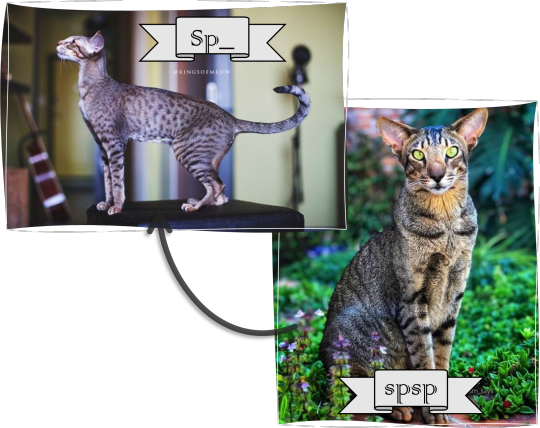
Alone the Sp allele makes a black (brown ect) spotted tabby cat; of course, in combinations with other variant alleles, it can produce a wide variety of different colored spotted tabbies.
Both a and Ti covers up the spotted gene: its effect normally only visible on a cat with the A_ titi genotype.
Mackerel [i use the name mackerel since every other gene here is named after the dominant allele] (transmembrane aminopeptidase Q, Taqpep): this gene determines the type of the tabby pattern.
Blotched and classic are synonym terms.
dominant allele: TMc - narrow vertical lines, mackerel tabby cat (wild type)
recessive allele: tbl - wide, swirling lines, blotched or classic tabby cat (variant)
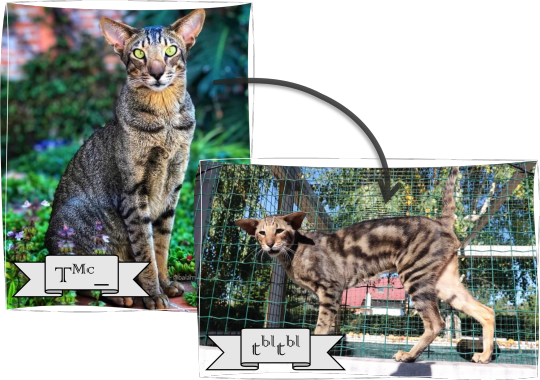
If every other gene is wild type except this, we'll have a black blotched tabby cat, but of course the tbl allele can produce lots of different colored classic tabbies.
All of the previously mentioned genes are able to nullify the effect of this one, so a mackerel or a blotched tabby must have A_ titi spsp genotype.
Additional annoyed remark: Despite the name, the so-called classic pattern is actually both the newer and the less common worldwide. My only guess for why it's named like that: it's the more common one in England. Well, thanks. (That's why I actually prefer the name blotched over classic.)
Brown (tyrosinase-related protein-1, TYRP1): this gene determines the quantity of the functional eumelanin.
dominant allele: B - full pigment production, black cat (wild type)
"middle" allele: b - less pigment, chocolate cat (variant)
recessive allele: bl- even less pigment, cinnamon cat (variant)
Order of dominance: B > b > bl
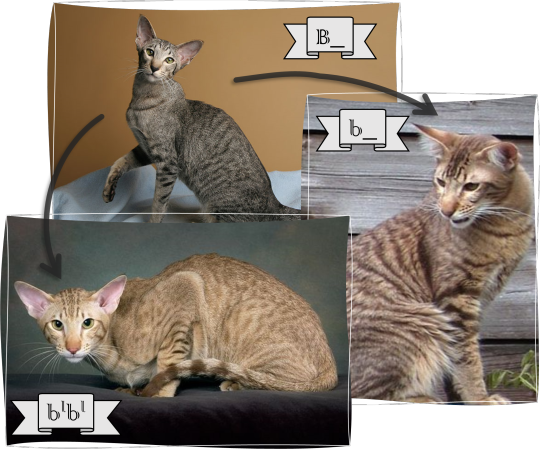
If every other allele is wild type except this, we'll have a chocolate or cinnamon mackerel tabby cat. (On the picture the cinnamon cat is spotted rather than striped, because i couldn't find a decent mackerel. So sad.) Chocolate and cinnamon cats are possible in every pattern.
Dilute (melanophilin, MLPH): this gene determines the distribution of the pigments.
dominant allele: D - even pigment distribution, dark cat (wild type)
recessive allele: d - clumped, uneven pigment distribution, diluted cat (variant)
black -> blue
chocolate -> lilac
cinnamon -> fawn

In these pictures the difference isn't that striking between the black and the blue mackerel tabby, but if you look up at the header, in solid cats it's much more pronounced.
For further comparison of undiluted and diluted color pairs on one picture (to eliminate differences in lightening):
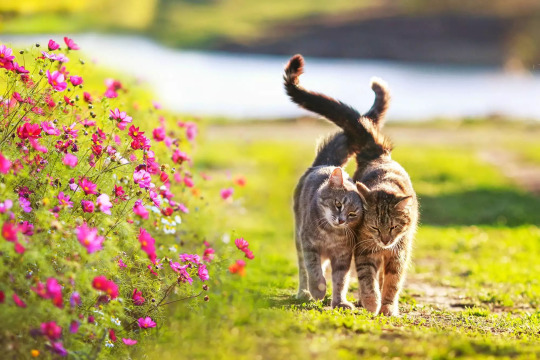

black vs blue and red vs cream
Every possible color and pattern can be diluted (with the only exception of white).
Orange (?): this yet unidentified gene determines the type of the most prominent pigment: eumelanin on pheomelanin.
allele: O - mainly pheomelanin, red-based cat (variant)
allele: o - mainly eumelanin, black-based cat (wild type)
This gene is special in two related ways: first, it's located on the X chromosome, which means tomcats only have one allele; second, the alleles are codominant - if a cat carries both of them, it'll show both phenotypes: this is how we get tortoiseshell cats. This explains why almost all tortoiseshell cats are females - every tortie needs two different X chromosomes.

Combined with other variant alleles every possible color and pattern can occure as tortoiseshell, but the O allele is epistatic over a lot of genes: for example agouti (the phenotype of every orange cat is tabby, even the genetically solid ones) and brown (since eumelanin is mostly absent thus can't change - the genotypes OO B_, OO b_and OO blbl all mean red cat).
The dilute version of red is called cream.
The dilution level is always the same in the colors of a tortoiseshell: the undiluted black, chocolate and cinnamon is paired with red, the diluted blue, lilac and fawn are paired with cream.
White (receptor tyrosine kinase, KIT): this gene determines the size of the area the pigment producing cells (the melanocytes) reach.
dominant allele: W - basically no melanocytes, white cat (variant)
allele(s): ws - limited area is covered, white-spotted cat (variant)
allele: w - all of the body is covered by the melanocytes, full-colored cat (wild type)
recessive allele: wg - only the paws remain white, gloved cat (variant)
Order of dominance: W > ws = w > wg

Since the gloving allele is kind of specific to the breed, I used a birman cat to illustrate it.
Lots of alleles here! Actually I'm not sure what's the most accepted opinion about them, but since these variant are all mapped to KIT, I considered them alleles.
If every other gene shows the wild type except for this, we'll have a white, or a white-spotted black mackerel tabby cat, but thanks to the ws allele(s) every color and pattern can be combined with white patches. However, the W allele is epistatic over every other gene: if a cat has one or two copies of W, it will be white regardless everything else.
ws is interesting: it has an additive effect, a cat with the wsws genotype will have more white than a cat with only one copy of it.
wg is fully recessive: the gloved phenotype only present if the cat's genotype is wgwg.
Color restriction (tyrosinase, TYR): mutations on this gene will result in temperature-sensitivity in the pigment production, the cats will be lighter on the warm and darker on the cooler areas of their bodies.
dominant allele: C - regular pigment production, full colored cat (wild type)
allele: cb - moderately reduced pigment production: burmese color restriction, sepia cat (variant)
allele: cm - reduced pigment production, bangkok color restriction, mocha cat (variant)
allele: cs - highly reduced pigment production: siamese color restriction, pointed cat (variant)
recessive allele: c - no pigment production, albino cat (variant)
Dominance order: C > cb = cm = cs > c
Now this group is a lot. Not only five different alleles (mocha was found relatively recently in Thailand), but the middle three are all intermediate with each other meaning that actually we have eight different phenotypes (illustration from messybeast; full color and albino are absent):
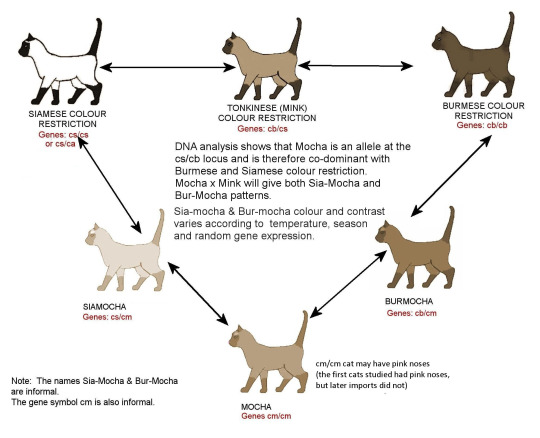
I used solid cats for illustration, because in the thai breed (the cats i used belong to this) they are often preferred over tabbies, so it's easier to find pictures; also, it's much more simple to compare them.
(Photos from The Thai Cat Center and Bangkok Mocha Cat, and Pangur from @pangur-and-grim as an albino cat)
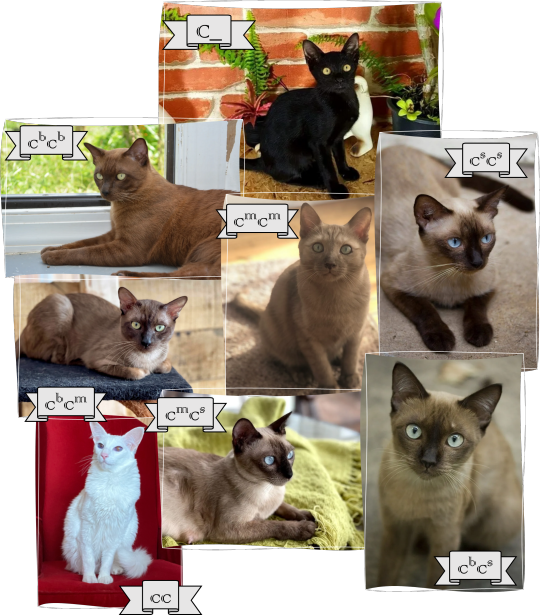
Please note that all of these varieties are very changeable; the pictures (especially those of the heterozygotes) are far from representing all cats carrying the respective genotypes.
Alone these variants makes some type of a black (seal) mackerel tabby point cat, but every type of color restriction can occure together with all possible colors and patterns.
***The color restriction gene won the Cat Color Gene Tournament!***
Inhibitor (?): this unidentified gene reduces the pheomelanin production, thus removes the warm tones of the fur (the hairs have white-black banding instead of yellow-black).
dominant allele: I - reduced pheomelanin, cooler toned cat (variant)
recessive allele: i - normal pheomelanin, warmer toned cat (wild type)
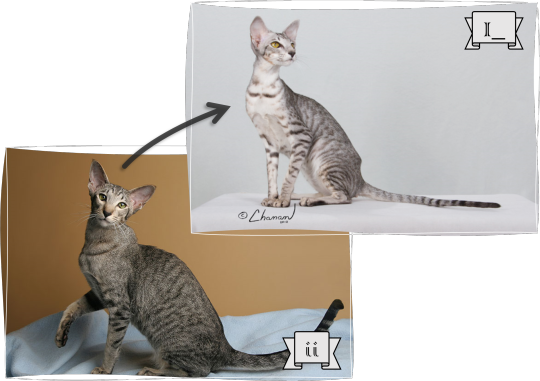
If every other allele is wild type except for this, we'll have a black silver mackerel tabby cat. Combined with other alleles it can produce lots of different silver (tabby) and smoke (solid) varieties.
Wide band (?): This hypothetic gene makes the yellow bands on the agouti hairs wider, resulting in a lighter, yellowish pelt. Based on the width of the pale bands we can differentiate between golden (middle band width) and shaded (maximal band width, color is pushed up into the tip).
dominant allele: Wb - reduced area of eumelanin, warmer toned cat (variant)
recessive allele: wb - normal area of eumelanin, cooler toned cat (wild type)
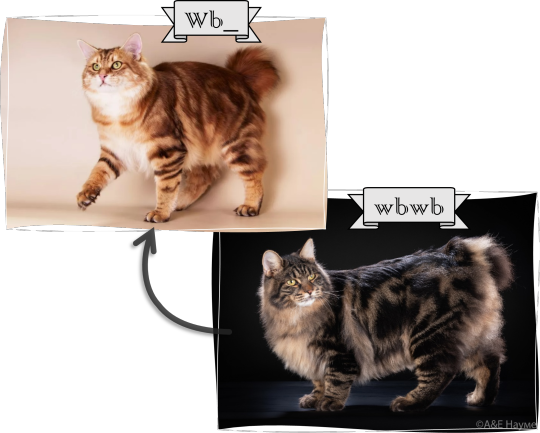
Golden is quite a mess; right now there is one identified gene (found first in siberians), but persians and many more breeds must have different gene(s), based on the interaction with the inhibitor gene (siberian golden + silver = bimetallic, persian golden + silver = silver shaded or chinchilla), and the inheritance patterns (the siberian alleles are recessive, while persian golden appears to be dominant). Since lots of breeds allow golden, and sometimes it can be found even in stray cats, I say who knows what genes and alleles are out there! This is all a hardly understood, very exciting and currently researched area.
If every other gene stays wild type except for this, we'll have a black golden mackerel tabby or a black golden shaded cat. Combined with other alleles it can produce lots of different golden and silver varieties.
Low-grade white (?): Again, hypothetic gene(s). Even with the extreme variability of the white spotting allele(s), the existence of some independently inherited genes is strongly suspected. Their effects most commonly manifest as a white locket: a small white patch on the chest or the belly, and/or a white tail tip. I'm not sure if there is any consensus whether these are more likely to be recessive or dominant alleles.
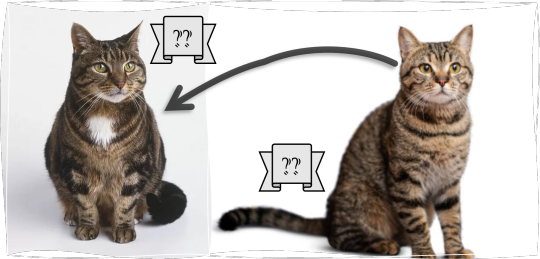
Dilute modifier (?): This unidentified gene changes the color of a diluted cat, the coloration becomes more brownish.
dominant allele: Dm - (variant)
recessive allele: dm - (wild type)
blue, lilac, fawn -> caramel
cream -> apricot
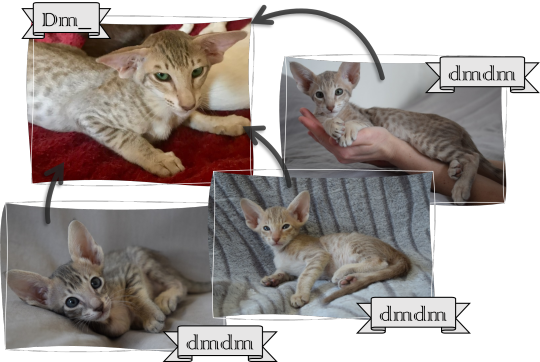
I put here a cat in all three diluted colors to compare them with the caramel tabby. It's hard to spot the differences, isn't it?
Since this is a dilute modifier, the D allele covers it, and we can only see its effect on cats with dd genotype.
It can be found only in a few breeds: orientals (including related breeds), burmese, different rexes. To our current knowledge, of course.
Extension (melanocortin 1 receptor, MC1R): This gene replaces eumelanin with pheomelanin resulting in a yellowish or reddish furred cat. The change often happens gradually during the first years of the cat's life.
dominant allele: E - eumelanin remains, black adjacent cat (wild type)
recessive alleles: e, er, ec - pheomelanin takes over, yellow/red adjacent cat: amber, russet or serdolik (variant)
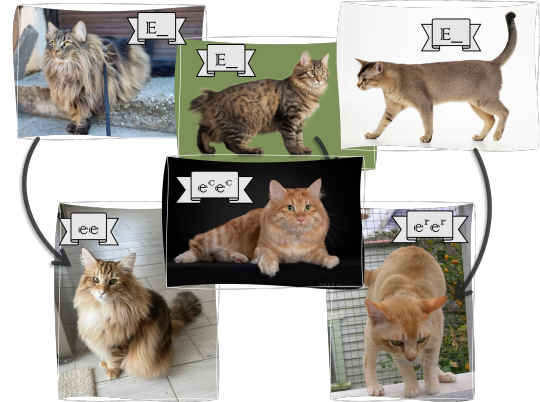
All three recessive variants are new mutations found recently in different breeds: the color amber in the 1990s in norwegian forest cats, the color russet in 2007 in burmese, and the color carnelian or serdolik in 2018 in kurilian bobtails (at least that's the first mention). We don't know anything about their interactions, or their effects on cats outside of their respective breeds.
The gene only effects eumelanin, so the O allele is epistatic over the it. However, because of the properties of the overpowering pheomelanin, every e allele is epistatic over agouti, so the tabby patterns will show up on aa cats as well.
Wide band (serine peptidase, CORIN): This hypothetic gene makes the yellow bands on the agouti hairs wider, resulting in a lighter, yellowish pelt.
dominant allele: Wb - eumelanin on normal sized area, darker cat (wild type)
recessive alleles: wbSIB, wbeSIB, wbBRI - eumelanin on reduced area, lighter cat (variant)

Ohhh, citizens of tumblr, we're really in it now. So. In the moment, we have, I believe, three mutations found on this gene: the sunshine (wbSIB) and extreme sunshine (wbeSIB) in the siberian breed, and the copper (wbBRI) in british cats. (I only show the sunshine and the copper here.) The novelty of these mutations means that the breeders still often call them simply golden instead of the new names, so it's difficult to find reliable data. Further complicating the situation, most likely both breeds have more wide band gene(s) beyond CORIN, and especially the copper cat above is the result of the combination of several wb genes.
Karpati (?): This unidentified gene makes the extremeties (face, ears, legs, tail) white kinda like a reverse colorpoint cat, and causes a roaning effect: scatters white hairs everywhere on the body.
dominant allele: K - whited extremities, karpati cat (variant)
recessive alleles: k - normal pigmant production, full colored cat (wild type)

Karpati seems to show intermediate inheritance with significantly more white on a homozygous then a heterozygote cat. This gene is studied for a very short time, and mostly on heterozygotes since they are much more common. The cats appearence changes during their life and also with the seasons: they born very similar to a fever coated kitten but with white ears, then to the end of their first year they almost completely lose the white (at least the heterozygous cats - the homozygotes become darker but still keep strange white patterns), then slowly gain it back as they age.
The karpati mutation is present in the stray cat population in middle-east Europe (including Hungary where I live, wahoo! and indeed, I can regularly see one or two karpaties in facebook adoptions groups and such). It's also introduced to some established breeds (LaPerm, Sphynx ect) and the creation of its own breed also began under the Transylvanian name.
2K notes
·
View notes
Text
What I'd name every chicken color allele if I got to choose:
This is just for fun. Some gene names are very apt and some are just plain confusing! Some have good names in some regions and poor names in others.
E/Extended Black: Already perfection. Tells you exactly what you are getting.
E^R/Birchen: This one is pretty good but it implies a birch tree, which people typically picture as black and white while gold birchen (which is closer to wild type than silver birchen.) However, some species of birches can have golden bark so maybe those who picture silver birchen when I say "birchen" need to touch up their botanical skills.
e+/Duckwing: Apparently this name is so attrocious fanciers decided to rarely use it! Not good! "Duckwing" is in reference to the wing bay (secondary feathers) on roosters bearing some resemblance to the colored speculum (secondary feathers) on ducks. However, this is not a good distinction as Wheaten and Partridge roosters have identical wing colorations to duckwing. Also, why mention ducks when we are talking about chickens? The relation is tenuous. We could define it based on the down color. How about "Chipmunk"? The resemblance to actual chipmunks is uncanny.
e^Wh Wheaten: I could not improve upon this perfection. Not only does it perfectly match the hens, it matches the chicks, too! They are like the golden wheat.
e^b Partridge: Partridge was named after the down color. And it was perfect. They match Hungarian partridge chicks perfectly. Unfortunately, partridge has been ruined by confusion. Too many people have used "partridge" to describe duckwing (in Europe partridge is duckwing and "Asian Partridge" is partridge.) Plus "partridge" is used to describe concentric lacing which isn't the same as just the partridge gene. I propose "Extended Brown." It is called e^b, not e^p. Plus "Extended Brown" exists in quail and it bears many similarities.
Co/Columbian: Sure why not? No confusing this gene. Lots of people misspell it though. (Columbian, not Colombian.)
Db/Darkbrown/Ginger: Ginger, which is what you call a duckwing bird with the ginger gene, describes the effect perfectly. Unfortunately, Dark Brown, not so much. If the abbreviation was just Gi, it would be so much better.
Pg/Pattern Gene: Yes.
Ml/Melanotic: Melanotic is a melanizer? Novel concept!
Cha/Charcoal: Charcoal is a decent descriptor. But I think "Moorhead" is even better.
Mh/Mahogany: Mahogany is a red enhancer. Mahogany is more of a brown wood. I think "Maroon" is a better descriptor but "Mahogany" sounds more natural so I'll allow it.
Di/Dilute: What does it dilute, exactly? Please be more specific. Oh? It dilutes gold and inhibits black a little? Why not call it "Peach" or something, goodness gracious.
ig/Cream: I've also heard it called "Inhibitor of Gold" but I'll stick to cream, thank you.
Cb/Cb/Cream blond/champagne blond: Perhaps I've hallucinated it but I thought this was called champagne blond, not cream blond. Champagne blond is a good descriptor but there can't be two "creams" so that has got to go.
Si/Silver: As opposed to gold. I like it!
B/Barred: Perfect.
choc/Chocolate: Chocolate is the perfect description, however, I must ask, why is the abreviation so long? "choc"? Really?
I/Dominant White: I mean, its more like codominant white, or something. And it only turns the black white, usually. Maybe "Pyle?"
i^d/Dun: Already perfect, unfortunately people keep calling it "chocolate."
Bl/Blue: I know I've complained about the way "blue" often removes the blue sheen, but I actually do consider it a good description of how the pigment is distributed, and it is used in many species of poultry in the same way.
mo/Mottled: Perfect.
c/Recessive White: Probably the best name anyone has ever concieved.
Lav/Lavender: I think "lavender" is just fine but it seems the APA finds it too flowery and insists on calling it "self blue" even though it is not blue and does a lot more than change the eumelanin to blue. Perhpas taking the approach of calling it "pearl-grey" like continental Europe will have the same effect, but I think it's worth a shot. I guess abbreviating it to "pearl" might help it further, considering how much we Americans like our brevity.
2 notes
·
View notes
Text
Hey I researched a lot about cat coat genetics (it's a really fun subject!!) But I think where your problem comes from is a bit of missing info about how genes work in general ^^.
I don't mean for this to sound patronizing or anything, I just enjoy explaining things I find interesting!! So if some of this stuff is too basic and you knew it already, I didn't mean any disrespect. And if someone who knows a lot about genetics is reading this, I'm probably gonna simplify some things. Don't kill me.
First up, what is a gene?
A gene is a piece of DNA, which is responsible for telling the cells how to build proteins, which cause a specific trait. What is an allele, then? An allele is a variant of a specific gene. For example, in cat coat genetics, we have the gene that influences the color of eumelanin -- the black or brown pigment in cat fur. It has three alleles -- B (the dominant one) - which creates black eumelanin, b (recessive) - brown eumelanin and b’ (double recessive) - which creates cinnamon eumelanin.
Every cat has two copies of every gene, with some exceptions.
But why?
Because genes come on chromosomes. And chromosomes come in pairs. Chromosomes are larger portions of DNA, which contain many genes. All the chromosomes in a cell create the full DNA of the cell. In general, we get one chromosome in a pair from our mom, and the other from our dad. Cats have 18 pairs of chromosomes. Humans have 23. Out of the 18 pairs of chromosomes in cats, 17 are what we call autosomes. Autosomes in a pair are very similar to each other in build, and each of them will have one allele (one variant) of a gene that is located on that chromosome (when a gene is located in a specific place, we call that place its locus. The plural of that is loci). For example, the locus of the gene that encodes the color of the eumelanin is on the cat chromosome pair number 13 (that pair is also called D4). Every cat, both male and female, will have two chromosomes number 13. So, every cat has two alleles of the TYRP1 gene, which determines what color the eumelanin will be.
So, the options are as follows:
BB - black eumelanin
Bb - also black, as B is dominant over b
Bb’ - same as above
bb - brown (also called chocolate)
bb’ - chocolate is dominant over b’, even though it is recessive to B. That’s why we call b’ double recessive.
b’b’ - cinnamon
If a cat has two different alleles of a given gene, we call them heterozygous in respect to that gene. So a cat with Bb is heterozygous. If the two alleles are the same, we call them homozygous. BB, bb and b’b’ are homozygous.
There are, in general, two types of dominant genes. Some are fully dominant, and some are partially dominant. You can tell which one you’re dealing with by looking at heterozygotes (specimens, which have two different alleles). If a heterozygote (for example, Bb) looks the same as a dominant homozygote (BB), then you’ve got a fully dominant gene. That means that in a heterozygote, the recessive gene is not expressed at all. There are also cases, where a heterozygote looks different than the dominant homozygote -- in cats, an example of that would be the white spotting gene (which controls how much white there is on a cat). Slightly simplifying, if a cat has two copies of the dominant S allele (which causes white spots) it will generally be 50-100% white. If the cat has two copies of the recessive s allele (no spotting) it will not have any spotting. If spotting behaved like eumelanin color, an Ss cat would have 50-100% spotting, right? But an Ss cat has 0-50% spotting. Because S is only partially dominant over s.
Now, the Punnett squares. What do they mean?
So, we said that every cat will have two copies of each chromosome (yes, we’ll get to the sex chromosomes soon). We call that being diploid. Its gametes (eggs and spermatozoa) are haploid, which means they only have ONE copy of every chromosome. Which makes sense, right? They combine to create one diploid child, so TWO of each chromosome. Perfect. Now, which of the parent’s copies of the chromosome goes into the gamete? We don’t know. But one will. And all the alleles (simplifying) on that chromosome will get in as well. And that’s where the Punnett square comes in. We look at the alleles each parent has (for example, mom is Bb and dad is bb’) and we see what gametes they can have. Mom has the B allele and the b allele on her 13th chromosomes, so all her gametes (which have only one 13th chromosome) will have either a B allele or a b allele. It’s a 50% chance. Dad has b and b’ alleles, which means his gametes will either have a b allele or a b’ allele.
Punnett squares make it easier to keep track of the combinations. We put in all possible gametes from the mother in the first column, so B and b, and then we put in all the possible gametes from the father in the first row. Then we fill it out: at the intersection of B and b we put Bb, b and b is bb, B and b’ is Bb’, and b and b’ is bb’.
So, the resulting genotypes for the possible children are:
Bb (black)
bb (chocolate)
Bb’ (black)
bb’ (chocolate)
Each of these genotypes has a 25% chance of happening. The effects of every genotype (given here in parentheses) are called phenotypes. Even though we have four different genotypes here, we have only two phenotypes. So, statistically, half the kittens of this mom and dad will have black eumelanin and half will have chocolate eumelanin.
Got that? Now onto the funky stuff.
Not everything is that simple -- sometimes genes interact with each other. One of those interactions is called epistasis. Epistasis means an effect of one gene masks an effect of another gene. A good example is a gene of baldness vs a gene of blonde hair -- if you have no hair, you can’t see that genetically you have blonde hair. You still DO have blonde hair in your genes. It’s just not expressed. (meaning, the genes are there, but the phenotype doesn’t show it). We need that definition, and we also need one extra definition in order to explain the red pigment (pheomelanin) in cats.
So, onto the sex-linked genes. Are you excited? I’m excited. This is super cool.
Remember how all the chromosomes have their pair? And how the chromosomes in the pair are built very very similarly? There is an exception to that, and those are the sex chromosomes (we also call them heterosomes). Heterosomes have two variants -- X and Y. The X chromosome is much bigger than the Y chromosome. Females have two X chromosomes, and males have one X and one Y chromosome. Some genes have their loci on the X chromosome. Which means, males have only ONE copy of that gene, only one allele. Females will have two copies.
What does that mean in practice?
In cats, whether a cat has pheomelanin or not, is controlled by a gene that has its locus on the X chromosome. It has two alleles -- O (pheomelanin--yes) and o (pheomelanin--no). Which means that a male cat (who has only one X chromosome) can only be either O - red or o - non red. When doing Punnett squares, we often denote a male cat as, for example, XOY (usually that would be X^O Y, but I'm not going to format it all again after I copied this from my notes lol. A female cat has two X chromosomes, which gives us three options: XOXO, XOXo and XoXo. The OO option gives us a red female cat. The oo option gives us a non-red female cat (which just means the cat expresses her eumelanin-based color). The Oo option creates a tortoiseshell cat.
Feel free to skip this explanation why <3 I just think it’s cool so I’m including it :>
Basically, a cell (with some exceptions) can only have one active X chromosome. So one of the X chromosomes will always get turned off in a female cat. So, if we have one X chromosome with the dominant O allele, and one X chromosome with the recessive o allele, depending on which one is turned on in which cell we get different pigments!!! Because a cell that has only the XO (dominant allele) chromosome turned on, will be producing pheomelanin. A cell which has only the Xo (recessive allele) chromosome turned on, will not be producing pheomelanin, which means it will produce eumelanin!! Cool, isn’t it :>
So, back to Punnett squares. Let’s say you have a red male cat and a non-red female cat. The male cat’s genes are XOY (an X chromosome with the dominant O allele and a Y chromosome. With no allele of that gene) and the female cat’s are XoXo (two X chromosomes, both with the recessive o allele). Dad’s gametes will then either have an X chromosome with O, or a Y chromosome. Mom’s gametes will all have an X chromosome with o (recessive), as that is the only allele of that gene she has (she’s homozygous). So, our Punnett square will have only two cells. In the first row, we put dad’s gametes: XO and Y. In the first column we only have Xo, which is the only type of gamete the mom produces. Which means the resulting combinations will be XOXo (a tortoiseshell female) or XoY (a non-red male).
Here’s that Punnett square:

you can also do them on multiple genes at once. Let’s say mom is a heterozygous chocolate cat, and dad is red (but his eumelanin is heterozygous black/chocolate).
Mom’s genes are then XoXobb’ (since she’s non-red, both her o alleles are recessive. A heterozygous (so different alleles) chocolate cat has to be bb’, since Bb is a black cat. not chocolate.)
Dad is XOYBb (red, so dominant O. XY cause male. Bb is a black/chocolate heterozygote, even though the cat is red, so you can’t see the black color).
Mom’s gametes each get a copy of the Xo chromosome, as well as one copy of the 13th chromosome -- with either a copy of the b allele or a copy of the b’ allele. Which means her gametes are either Xob or Xob’.
Dad’s gametes will have either an XO chromosome or a Y chromosome, and a copy of the 13th chromosome with either a copy of the B allele or a copy of the b allele. So, dad’s possible gametes will be XOB, XOb, YB, and Yb.
So, the Punnett square looks like this:

I hope I've explained myself well and that that makes more sense to you now. The wikipedia page on cat coat genetics is a good resource for all the other different things that factor into the appearance of a cat, if you were looking for that — as is the messybeast page.
Male Cats are Confusing >lT
OK, so I’ve got a question. How do male cats pass down color genes? If only the X carries color, how does the male pass on genes like Bb? Or are his genes always homozygous? BB instead of Bb, and bb father and Bb or bb mother is the only was to have a bb or Bb child.
Does… that make sense?
I started a cat genetics project years ago and realized half way through that the male cats color genetics are weird as hell. I kinda just quit the project after that, but I’m starting something similar and this remains an issue.
At first I though a male could have both orange and black genes, so thats what I put down in the punnet squares, however this is apparently not the case.
I basically need an in depth guide to male cat genetics and how to use punnet squares with them.
#genetics#cats#cat coats#cat coat genetics#sorry for talking so much on your post i just had my genetics exam two days ago
32 notes
·
View notes
Text
im just gonna go ahead and write up my punnett square stuff anyway because i got nowhere else to put this stuff.
ill do them in order from simplest to most complicated. theres four of them, and they are; skin color, hair color, hair texture, and eye color. ill explain my reasonings for them as i go.
skin color. heres a chart i made for it.

for this i assume there is 3 genes involved, each with dominant and recessive allele forms. for simplicity i call them A,B, and C. the numbers on the left side of the chart correspond to the number of dominant alleles a person has.
so someone who is AABBCC has 6 dominant alleles, and so would have the very dark brown phenotype, while someone who is AaBbCc only has 3 dominant alleles and so would have the olive phenotype. BUT someone who is aaBBCc also has 3 dominant alleles and so has the same skin color as someone with AaBbCc, or AAbbCc, AaBBcc, etc.
of course in real life this is going to me much more complicated, going to have way more genes involved, but we actually even know all the details yet so im keeping it simple. the categories are based off this system i found on Wikipedia.
hair color.
this is the one im happiest with.

in this one the numbers work the same way, with made up genes called, say, D, E and F, which control general melanin level. but this time, we have a specific gene, R, which controls for redness. red is a recessive trait, which means RR = no red at all (or “ash brown/blonde” as i like to call it), Rr = some redness but still masked by the brown, and rr = that full red, babey.
in real life, theres two main kinds of melanin that effect human pigmentation. eumelanin is brown/black and is controlled by the made up D, E, and F genes in this model. pheomelanin is reddish. the higher ratio of pheomelanin to eumelanin you have in your hair = the more red it is.
i based the red hair naming categories of this article i found while googling this shit at 1 am probably.
hair texture.
i am not happy with this one at all.

as it turns out, hair texture is a co-dominant trait rather than a recessive or dominant trait. this system proposes that there are 20 “allele slots” or w/e that can code for either curly or straight hair. C = curly, S = straight. you inherit a random 10 from each of your parents. the more C’s you have, the more curly your hair is. the hair categories are based off this system, which has been added to by other people to have 4c and 3c categories and is meant to be used for hair care.
in fact, this system i have made is already severely lacking because apparently african and asian hair types are supposed to work differently from European hair types, but no one has done any research on this for a long time because of its association with racism (same with skin color) . so for the time being i make do. until we have more information i will just have to use this inherently flawed chart TT_____TT.
eye color.
this one is the most complicated.

in this chart we start with the O’s and H’s on top, which are based off of real genes and behave as a switch for blue eyes. for someones eyes to be on the “brown” side of the chart, they must have at least 1 working copy of both the O and H gene. if either of these genes are homozygous recessive, oo or hh, then eyes are automatically either blue or grey. do not pass go do not collect $200. likewise, if they dont have oo or hh a persons eyes cannot be blue or grey. in this way two parents with blue eyes can have a brown eyed child, even though blue is supposed to be a recessive trait and high school bio textbooks would have you think this was impossible.
but then what about green eyes, or hazel, or different shades of brown? for this we look at the rest of the chart, and also this other chart i compiled about the make up of whats actually in different colored eyes:

you will notice eumelanin and pheomelanin again, they do the same things in eyes as they do in hair. then you also have general melanin level and collegen level.
collegen is important in light reflecting in the eyes and seems to be the main difference between blue and grey eyes. there is no blue pigment in humans-- the appearance of blue eyes is caused by the same light reflection process that makes the sky blue. this happens when there is none or little melanin or collegen in the eyes. when there is collegen in the eyes, but still no melanin, it fucks up this light reflection process and makes the eyes look grey instead of blue.
but apparently collegen isnt a pigment at all, so i just call it a dominant trait called C and if you have CC or Cc and are on the blue side of the chart you have grey eyes. cc = blue.
on the brown side, M controls for eumelanin level, which can be high, medium, or low. MM automatically = dark brown. P controls for pheomelanin and is important for amber, hazel, and green eyes.
you may also notice an aqua category on the chart. apparently thats a sort of blue-ish green-ish hazel-ish color. i found it in this chart , which is part of a real typing system but the wiki page doesnt have the picture. i didnt know what to do with that space in my chart so i put aqua there because it sort of fit lol.
ill end it here cause this is super long
8 notes
·
View notes
Text

Description of the genes under the break
Beware, this one is even longer!
Genetics guide
Brown (tyrosinase-related protein-1, TYRP1): this gene determines the quantity of the functional eumelanin.
dominant allele: B - full pigment production, black cat (wild type)
"middle" allele: b - less pigment, chocolate cat (variant)
recessive allele: bl - even less pigment, cinnamon cat (variant)
Order of dominance: B > b > bl
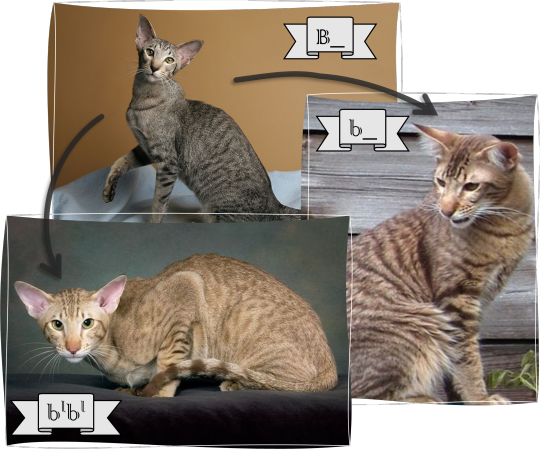
If every other allele is wild type except this, we'll have a chocolate or cinnamon mackerel tabby cat. (On the picture the cinnamon cat is spotted rather than striped, because i couldn't find a decent mackerel. So sad.) Chocolate and cinnamon cats are possible in every pattern.
Dilute (melanophilin, MLPH): this gene determines the distribution of the pigments.
dominant allele: D - even pigment distribution, dark cat (wild type)
recessive allele: d - clumped, uneven pigment distribution, diluted cat (variant)
black -> blue
chocolate -> lilac
cinnamon -> fawn
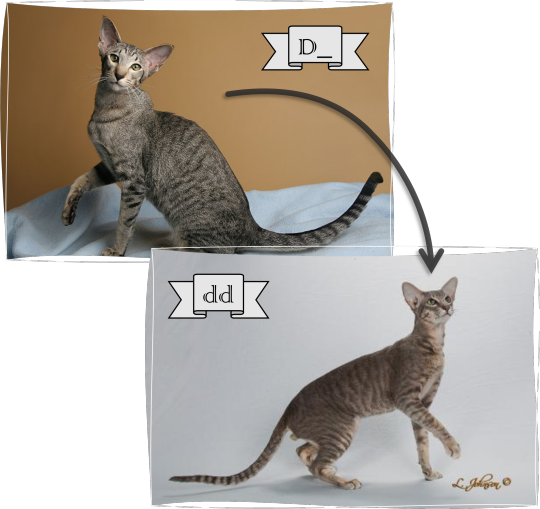
In these pictures the difference isn't that striking between the black and the blue mackerel tabby, but if you look up at the header, in solid cats it's much more pronounced.
For further comparison of undiluted and diluted color pairs on one picture (to eliminate differences in lightening):


black vs blue and red vs cream
Every possible color and pattern can be diluted (with the only exception of white).
Orange (?): this yet unidentified gene determines the type of the most prominent pigment: eumelanin on pheomelanin.
allele: O - mainly pheomelanin, red-based cat (variant)
allele: o - mainly eumelanin, black-based cat (wild type)
This gene is special in two related ways: first, it's located on the X chromosome, which means tomcats only have one allele; second, the alleles are codominant - if a cat carries both of them, it'll show both phenotypes: this is how we get tortoiseshell cats. This explains why almost all tortoiseshell cats are females - every tortie needs two different X chromosomes.

Combined with other variant alleles every possible color and pattern occure as tortoiseshell, but the O allele is epistatic over a lot of genes: for example agouti (the phenotype of every orange cat is tabby, even the genetically solid ones) and brown (since eumelanin is mostly absent thus can't change - the genotypes OO B_, OO b_ and OO blbl are all means red cat).
The dilute version of red is called cream.
The dilution level is always the same in the colors of a tortoiseshell: the undiluted black, chocolate and cinnamon is paired with red, the diluted blue, lilac and fawn are paired with cream.
White (receptor tyrosine kinase, KIT): this gene determines the size of the area the pigment producing cells (the melanocytes) reach.
dominant allele: W - basically no melanocytes, white cat (variant)
allele(s): ws - limited area is covered, white-spotted cat (variant)
allele: w - all of the body is covered by the melanocytes, full-colored cat (wild type)
recessive allele: wg - only the paws remain white, gloved cat (variant)
Order of dominance: W > ws = w > wg

Since the gloving allele is kind of specific to the breed, I used a birman cat to illustrate it.
Lots of alleles here! Actually I'm not sure what's the most accepted opinion about them, but since these variant are all mapped to KIT, I considered them alleles.
If every other gene shows the wild type except for this, we'll have a white, or a white-spotted black mackerel tabby cat, but thanks to the ws allele(s) every color and pattern can be combined with white patches. However, the W allele is epistatic over every other gene: if a cat has one or two copies of W, it will be white regardless everything else.
ws is interesting: it has an additive effect, a cat with the wsws genotype will have more white than a cat with only one copy of it. wg is fully recessive: the gloved phenotype only present if the cat's genotype is wgwg.
#cats#cat genetics#genetics#macska#polls#tournament poll#brown#dilute#orange#white#white spotting#introductions#cat color gene tournament
36 notes
·
View notes